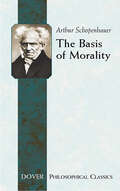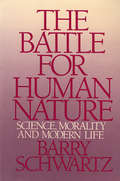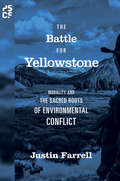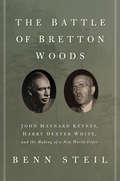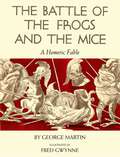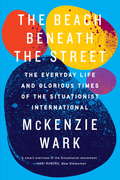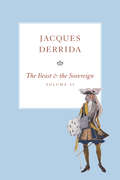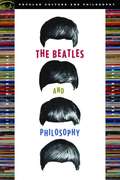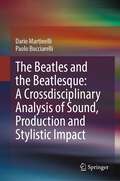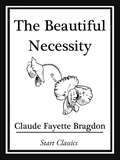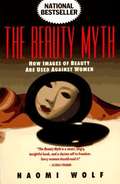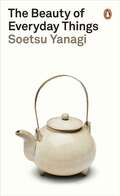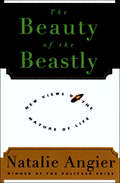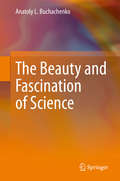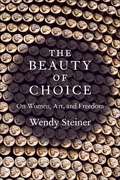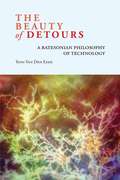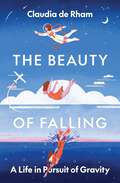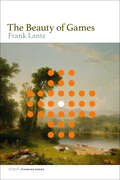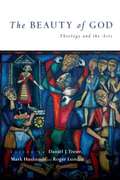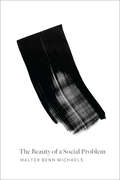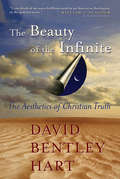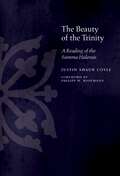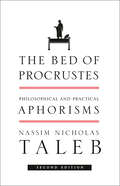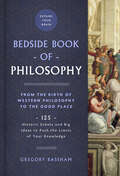- Table View
- List View
The Basis of Morality
by Arthur Schopenhauer Arthur Brodrick BullockPersuasive and humane, this classic of philosophy represents one of the nineteenth century's most significant treatises on ethics. The Basis of Morality offers Schopenhauer's fullest examination of traditional ethical themes, and it articulates a descriptive form of ethics that contradicts the rationally based prescriptive theories.Starting with his polemic against Kant's ethics of duty, Schopenhauer anticipates the latter-day critics of moral philosophy. Arguing that compassion forms the basis of morality, he outlines a perspective on ethics in which passion and desire correspond to different moral characters, behaviors, and worldviews. In conclusion, Schopenhauer defines his metaphysics of morals, employing Kant's transcendental idealism to illustrate both the interconnectiveness of being and the affinity of his ethics to Eastern thought.
The Battle for Human Nature: Science, Morality and Modern Life
by Barry Schwartz"Provocative and richly textured. . . .Schwartz's analyses of the inadequacies of contemporary scientific views of human nature are compelling, but the consequences are even more worthy of note." --Los Angeles Times Out of the investigations and speculations of contemporary science, a challenging view of human behavior and society has emerged and gained strength. It is a view that equates "human nature" utterly and unalterably with the pursuit of self-interest. Influenced by this view, people increasingly appeal to natural imperatives, instead of moral ones, to explain and justify their actions and those of others.
The Battle for Yellowstone: Morality and the Sacred Roots of Environmental Conflict
by Justin FarrellYellowstone holds a special place in America's heart. As the world's first national park, it is globally recognized as the crown jewel of modern environmental preservation. But the park and its surrounding regions have recently become a lightning rod for environmental conflict, plagued by intense and intractable political struggles among the federal government, National Park Service, environmentalists, industry, local residents, and elected officials. The Battle for Yellowstone asks why it is that, with the flood of expert scientific, economic, and legal efforts to resolve disagreements over Yellowstone, there is no improvement? Why do even seemingly minor issues erupt into impassioned disputes? What can Yellowstone teach us about the worsening environmental conflicts worldwide?Justin Farrell argues that the battle for Yellowstone has deep moral, cultural, and spiritual roots that until now have been obscured by the supposedly rational and technical nature of the conflict. Tracing in unprecedented detail the moral causes and consequences of large-scale social change in the American West, he describes how a "new-west" social order has emerged that has devalued traditional American beliefs about manifest destiny and rugged individualism, and how morality and spirituality have influenced the most polarizing and techno-centric conflicts in Yellowstone's history.This groundbreaking book shows how the unprecedented conflict over Yellowstone is not all about science, law, or economic interests, but more surprisingly, is about cultural upheaval and the construction of new moral and spiritual boundaries in the American West.
The Battle of Bretton Woods: John Maynard Keynes, Harry Dexter White, and the Making of a New World Order
by Benn SteilA sweeping history of the drama, intrigue, and rivalry behind the creation of the postwar economic orderWhen turmoil strikes world monetary and financial markets, leaders invariably call for 'a new Bretton Woods' to prevent catastrophic economic disorder and defuse political conflict. The name of the remote New Hampshire town where representatives of forty-four nations gathered in July 1944, in the midst of the century's second great war, has become shorthand for enlightened globalization. The actual story surrounding the historic Bretton Woods accords, however, is full of startling drama, intrigue, and rivalry, which are vividly brought to life in Benn Steil's epic account.Upending the conventional wisdom that Bretton Woods was the product of an amiable Anglo-American collaboration, Steil shows that it was in reality part of a much more ambitious geopolitical agenda hatched within President Franklin D. Roosevelt's Treasury and aimed at eliminating Britain as an economic and political rival. At the heart of the drama were the antipodal characters of John Maynard Keynes, the renowned and revolutionary British economist, and Harry Dexter White, the dogged, self-made American technocrat. Bringing to bear new and striking archival evidence, Steil offers the most compelling portrait yet of the complex and controversial figure of White—the architect of the dollar's privileged place in the Bretton Woods monetary system, who also, very privately, admired Soviet economic planning and engaged in clandestine communications with Soviet intelligence officials and agents over many years.A remarkably deft work of storytelling that reveals how the blueprint for the postwar economic order was actually drawn, The Battle of Bretton Woods is destined to become a classic of economic and political history.
The Battle of the Frogs and the Mice: A Homeric Fable
by George MartinYou will never see war the same way after reading this extraordinary retelling of an ancient Greek fable about a tragically unnecessary battle between mice and frogs. With haunting illustrations, this miniature masterpiece ranks with Animal Farm as one of the greatest parables of human foibles.Originally published in 1962, The Battle of the Frogs and the Mice tells in words and pictures a classic tale of the foolhardiness of war. When Crum-snatcher, a Mouse, cautiously mounts the back of Puff-jaw, King of the Frogs, to explore the Frogs’ pond, the Mouse meets with a disaster which soon brings the two nations into mortal conflict. The course of this tempest in a teapot is developed with wit to assume heroic proportions, and the battle of this small world becomes the story of wars through the ages.George Martin has made an imaginative, free adaptation of a fable originally ascribed to Homer, but now believed to have been written about three hundred years after him by an unknown author. The book’s events are brilliantly depicted by the drawings of Fred Gwynne, a versatile artist known for his role as Herman Munster in the sit-com hit The Munsters. Gwynne’s haunting and unsparingly illustrations portray this chronicle from its pastoral beginning to its bitter end. Together, Martin and Gwynne have made a book of grim delight for adults and young readers alike.
The Beach Beneath the Street
by Mckenzie WarkOver fifty years after the Situationist International appeared, its legacy continues to inspire activists, artists and theorists around the world. Such a legend has accrued to this movement that the story of the SI now demands to be told in a contemporary voice capable of putting it into the context of twenty-first-century struggles.McKenzie Wark delves into the Situationists' unacknowledged diversity, revealing a world as rich in practice as it is in theory. Tracing the group's development from the bohemian Paris of the '50s to the explosive days of May '68, Wark's take on the Situationists is biographically and historically rich, presenting the group as an ensemble creation, rather than the brainchild and dominion of its most famous member, Guy Debord. Roaming through Europe and the lives of those who made up the movement - including Constant, Asger Jorn, Michèle Bernstein, Alex Trocchi and Jacqueline De Jong - Wark uncovers an international movement riven with conflicting passions.Accessible to those who have only just discovered the Situationists and filled with new insights, The Beach Beneath the Street rereads the group's history in the light of our contemporary experience of communications, architecture, and everyday life. The Situationists tried to escape the world of twentieth-century spectacle and failed in the attempt. Wark argues that they may still help us to escape the twenty-first century, while we still can.From the Trade Paperback edition.
The Beast and the Sovereign, Volume II
by Jacques DerridaFollowing on from The Beast and the Sovereign, Volume I, this book extends Jacques Derrida's exploration of the connections between animality and sovereignty. In this second year of the seminar, originally presented in 2002-2003 as the last course he would give before his death, Derrida focuses on two markedly different texts: Heidegger's 1929-1930 course The Fundamental Concepts of Metaphysics, and Daniel Defoe's Robinson Crusoe. As he moves back and forth between the two works, Derrida pursuesthe relations between solitude, insularity, world, violence, boredom and death as they supposedly affect humans and animals in different ways. Hitherto unnoticed or underappreciated aspects of Robinson Crusoe are brought out in strikingly original readings of questions such as Crusoe's belief in ghosts, his learning to pray, his parrot Poll, and his reinvention of the wheel. Crusoe's terror of being buried alive or swallowed alive by beasts or cannibals gives rise to a rich and provocative reflection on death, burial, and cremation, in part provoked by a meditation on the death of Derrida's friend Maurice Blanchot. Throughout, these readings are juxtaposed with interpretations of Heidegger's concepts of world and finitude to produce a distinctively Derridean account that will continue to surprise his readers.
The Beatles and Philosophy: Nothing You Can Think That Can't Be Thunk
by Michael Baur Steven A. BaurIn this tribute to the Beatles, 20 Beatle-fan philosophers look at the Beatles' output backwards and forwards and dissect even the most puzzling of the Beatles' lyrics. The articles analyze such topics as the Beatles and Nietzsche, the Beatles and the critique of consumer culture, the Beatles and social philosophy and, perhaps most importantly, the hidden clues in the lyrics and album covers.
The Beatles and the Beatlesque: A Crossdisciplinary Analysis of Sound Production and Stylistic Impact
by Dario Martinelli Paolo BucciarelliThe Beatles and the Beatlesque address a paradox emanating from The Beatles’ music through a cross-disciplinary hybrid of reflections, drawing from both, musical practice itself and academic research. Indeed, despite their extreme stylistic variety, The Beatles’ songs seem to always bear a distinctive identity that emerges even more in similar works by other artists, whether they are merely inspired, derivative or explicitly paying homage. The authors, a musicologist and music producer, emphasize the importance of record production in The Beatles' music in a way that does justice not only to the final artifacts (the released songs) but also to the creative process itself (i.e., the songs "in the making").Through an investigation into the work of George Martin and his team, as well as The Beatles themselves, this text sheds light on the role of the studio in shaping the group's eclectic but unique sound. The chapters address what makes a song “Beatlesque”, to what extent production choices are responsible for developing a style, production being understood not as a mere set of technicalities, but also in a more conceptual way, as well as the aesthetics, semiotics and philosophy that animated studio activity. The outcome is a book that will appeal to both students and researchers, as well as, of course, musicophiles of all kinds.
The Beautiful Necessity
by Claude Fayette BragdonWritten in 1910, The Beautiful Necessity discusses architectural theory by American architect and writer, Claude Fayette Bragdon.
The Beauty Myth: How Images of Beauty Are Used Against Women
by Naomi WolfExplores the phenomenon of the violent backlash against feminism that uses images of female beauty as a political weapon against women's advancement.
The Beauty Of Everyday Things
by Soetsu YanagiThe Japanese philosopher and aesthete's definitive, hugely influential exposition of his philosophy of folkcrafts, setting out the hallmarks of Japanese design as we know it today: anonymity, quality, simplicity and honesty—and, of course, wabi-sabi, the beauty of imperfection A Penguin Classic Our lives are filled with objects. Everyday things used in everyday settings, they are our constant companions. As such, writes Soetsu Yanagi, they should be made with care and built to last, treated with respect and even affection. They should be natural and simple, sturdy and safe—an aesthetic fulfillment of our practical needs. They should, in short, be things of beauty. Long revered as the authority on craftsmanship and Japanese aesthetics, Yanagi devoted his life and writing to defend the value of craft. In an age of feeble and ugly machine-made things, The Beauty of Everyday Things is a call for each of us to deepen our relationship with the objects that surround us. Inspired by the work of the simple artisans Yanagi encountered on his lifelong travels through Japan and Korea, this now-classic book is a heartfelt defence of modest, honest, handcrafted objects, from traditional teacups to jars to paper—objects that exemplify the beauty of everyday things.
The Beauty Of The Beastly: New Views on the Nature of Life
by Natalie AngierNatalie Angier knows all that scientists know - and sometimes more - about the power of symmetry in sexual relations, about the brutal courting habits of dolphins, about the grand deceit of orchids, about the impact of female and male preferences on evolution. She knows how scientists go about their work, and she describes their ways, their visions, and their arguments. Perhaps most poignantly, she understands the complexities and the sad necessity of death. "The beauty of the natural world lies in the details, and most of those details are not the stuff of calendar art," she points out. Few writers have ever covered so many facets of biology so evocatively in one book. The Beauty of the Beastly tells us how the genius of the biological universe resides in its details and proves why, according to Timothy Ferris, author of the acclaimed Coming of Age in the Milky Way, Angier is "one of the strongest and wittiest science writers in the world today."
The Beauty and Fascination of Science
by Anatoly L. BuchachenkoIn this book, Professor Anatoly Buchachenko gives a brief and informative description of the most striking achievements and discoveries made in the major natural sciences at the turn of the century – in the late twentieth and early twenty-first centuries. The author has a rare ability to describe scientific discoveries so that these achievements and their significance are understandable not only by professionals and scientists of all specialities, but for any reader interested in modern science, its role in the existence of mankind, and its impact on human society. Originally published in Russian, Professor Buchachenko’s book describes the interaction of natural sciences with social ones—philosophy and history—as well as the part played by the human factor in the development of science, especially the role of the great scientists.
The Beauty of Choice: On Women, Art, and Freedom
by Wendy SteinerIn The Beauty of Choice, the renowned cultural critic Wendy Steiner offers a dazzling new account of aesthetics grounded in female agency. Through a series of linked meditations on canonical and contemporary literature and art, she casts women’s taste as the engine of liberal values.Steiner reframes long-standing questions surrounding desire, art, sexual assault, and beauty in light of #MeToo. Beginning with an opera she wrote based on Chaucer’s “The Wife of Bath’s Tale,” she presents women’s sexual choices as fundamentally aesthetic in nature—expressions of their taste—and artworks as stagings of choice in courtship, coquetry, consent, marriage, and liberation. A merger of art criticism, evolutionary theory, political history, and aesthetics, this book paints the struggle between female autonomy and patriarchal violence and extremism as the essence of art.The Beauty of Choice pursues its claims through a striking diversity of examples: Sei Shōnagon’s defense of pleasure in the Pillow Book; Picasso’s and Balthus’s sexualization of their models; the redefinition of “waste” in postmodern fiction; and interactivity and empathy in the works of contemporary artists such as Marlene Dumas, Barbara MacCallum, Kristin Beeler, and Hannah Gadsby. It offers the first critical study of Heroines, a memorial to the twenty thousand women raped in Kosovo during the Serbian genocide. This deeply original book gives taste, beauty, and pleasure central roles in a passionate defense of women’s freedom.
The Beauty of Detours: A Batesonian Philosophy of Technology
by Yoni Van Den EedeWinner of the 2020 S.I. Hayakawa Book Prize presented by The Institute of General SemanticsWinner of the 2020 Susanne Langer Award for Outstanding Scholarship in the Ecology of Symbolic Form presented by the Media Ecology AssociationThe Beauty of Detours proposes a new way of understanding and defining technology by reading systems thinker Gregory Bateson in the framework of contemporary philosophy of technology. Although "technology" was not an explicit focus of Bateson's oeuvre, Yoni Van Den Eede shows that his thought is permeated with insights directly relevant to contemporary technological concerns. This book provides a systematic reading of Bateson that reveals these under-investigated elements of his thought. It also critiques the field of philosophy of technology for still reifying "technology" too much despite its attempt to de-reify it, arguing instead that it should incorporate Bateson's insights and focus more on processes of human knowing. Sketching a Batesonian philosophy of technology, Van Den Eede calls for greater attentiveness to the purpose of technology and its role in our lives.
The Beauty of Falling: A Life in Pursuit of Gravity
by Claudia de RhamA world-renowned physicist seeks gravity&’s true nature and finds wisdom in embracing its force in her lifeClaudia de Rham has been playing with gravity her entire life. As a diver, experimenting with her body&’s buoyancy in the Indian Ocean. As a pilot, soaring over Canadian waterfalls on dark mornings before beginning her daily scientific research. As an astronaut candidate, dreaming of the experience of flying free from Earth&’s pull. And as a physicist, discovering new sides to gravity&’s irresistible personality by exploring the limits of Einstein&’s general theory of relativity. In The Beauty of Falling, de Rham shares captivating stories about her quest to gain intimacy with gravity, to understand both its feeling and fundamental nature. Her life&’s pursuit led her from a twist of fate that snatched away her dream of becoming an astronaut to an exhilarating breakthrough at the very frontiers of gravitational physics.While many of us presume to know gravity quite well, the brightest scientists in history have yet to fully answer the simple question: what exactly is gravity? De Rham reveals how great minds—from Newton and Einstein to Stephen Hawking, Andrea Ghez, and Roger Penrose—led her to the edge of knowledge about this fundamental force. She found hints of a hidden side to gravity at the particle level where Einstein&’s theory breaks down, leading her to develop a new theory of &“massive gravity.&” De Rham shares how her life&’s path turned from a precipitous fall to an exquisite flight toward the discovery of something entirely new about our surprising, gravity-driven universe.
The Beauty of Games (Playful Thinking)
by Frank LantzHow games create beauty and meaning, and how we can use them to explore the aesthetics of thought.Are games art? This question is a dominant mode of thinking about games and play in the twenty-first century, but it is fundamentally the wrong question. Instead, Frank Lantz proposes in his provocative new book, The Beauty of Games, that we think about games and how they create meaning through the lens of the aesthetic. We should think of games, he writes, the same way we think about literature, theater, or music—as a form that ranges from deep and profound to easy and disposable, and everything in between. Games are the aesthetic form of interactive systems, a set of possibilities connected by rules of cause and effect.In this book, Lantz analyzes games from chess to poker to tennis to understand how games create beauty and evoke a deeper meaning. He suggests that we think of games not only as hyper-modern objects but also as forms within the ancient context of artistic production, encompassing all of the nebulous and ephemeral qualities of the aesthetic experience.
The Beauty of God: Theology and the Arts (Wheaton Theology Conference Ser.)
by Daniel J. Treier Roger Lundin Mark HusbandsGod. Beauty. Art. Theology. Editors Mark Husbands, Roger Lundin and Daniel J. Treier present ten essays from the 2006 Wheaton Theology Conference that explore a Christian approach to beauty and the arts. Theology has much to contribute in providing a place for the arts in the Christian life, and the arts have much to contribute to the quality of Christian life, worship and witness. The 2006 Wheaton Theology Conference explored a wide-ranging Christian approach to divine beauty and the earthly arts. Written and illustrated by artists and theologians, these essays illuminate for us the Christian significance of the visual arts, music and literature, as well as sounding forth the theological meaning and place of the arts in a fallen world--fallen, yet redeemed by Christ. Here is a veritable feast for pastors, artists, theologians and students eager to consider the profound but not necessarily obvious connection between Christianity and the arts.
The Beauty of a Social Problem: Photography, Autonomy, Economy
by Walter Benn MichaelsBertolt Brecht once worried that our sympathy for the victims of a social problem can make the problem's "beauty and attraction" invisible. In The Beauty of a Social Problem, Walter Benn Michaels explores the effort to overcome this difficulty through a study of several contemporary artist-photographers whose work speaks to questions of political economy. Although he discusses well-known figures like Walker Evans and Jeff Wall, Michaels's focus is on a group of younger artists, including Viktoria Binschtok, Phil Chang, Liz Deschenes, and Arthur Ou. All born after 1965, they have always lived in a world where, on the one hand, artistic ambition has been synonymous with the critique of autonomous form and intentional meaning, while, on the other, the struggle between capital and labor has essentially been won by capital. Contending that the aesthetic and political conditions are connected, Michaels argues that these artists' new commitment to form and meaning is a way for them to depict the conditions that have taken US economic inequality from its lowest level, in 1968, to its highest level today. As Michaels demonstrates, these works of art, unimaginable without the postmodern critique of autonomy and intentionality, end up departing and dissenting from that critique in continually interesting and innovative ways.
The Beauty of the Infinite: The Aesthetics of Christian Truth
by David Bentley HartThe Beauty of the Infinite is a splendid extended essay in "theological aesthetics." David Bentley Hart here meditates on the power of a Christian understanding of beauty and sublimity to rise above the violence -- both philosophical and literal -- characteristic of the postmodern world.The book begins by tracing the shifting use and nature of metaphysics in the thought of Kant, Hegel, Nietzsche, Heidegger, Lyotard, Derrida, Deleuze, Nancy, Levinas, and others. Hart pays special attention to Nietzsche's famous narrative of the "will to power" -- a narrative largely adopted by the world today -- and he offers an engaging revision (though not rejection) of the genealogy of nihilism, thereby highlighting the significant "interruption" that Christian thought introduced into the history of metaphysics.This discussion sets the stage for a retrieval of the classic Christian account of beauty and sublimity, and of the relation of both to the question of being. Written in the form of a dogmatica minora, this main section of the book offers a pointed reading of the Christian story in four moments, or parts: Trinity, creation, salvation, and eschaton. Through a combination of narrative and argument throughout, Hart ends up demonstrating the power of Christian metaphysics not only to withstand the critiques of modern and postmodern thought but also to move well beyond them.Strikingly original and deeply rewarding, The Beauty of the Infinite is both a constructively critical account of the history of metaphysics and a compelling contribution to it.
The Beauty of the Trinity: A Reading of the Summa Halensis (Medieval Philosophy: Texts and Studies)
by Justin CoyleIn this book Justin Shaun Coyle remembers the theology of beauty of the forgotten Summa Halensis, an early-thirteenth-century text written by Franciscan friars at the University of Paris. Many scholars vaunt the Summa Halensis—conceived but not drafted entirely by Alexander of Hales (d. 1245)—for its teaching on beauty and its influence on giants of the high scholastic idiom. But few read the text’s teaching theologically—as a teaching about God. The Beauty of the Trinity: A Reading of the Summa Halensis proposes an interpretation of the Summa’s beauty—teaching as deeply and inexorably theological, even trinitarian.The book takes as its keystone a passage in which the Summa Halensis identifies beauty with the “sacred order of the divine persons.” If beauty names a trinitarian structure rather than a divine attribute, then the text teaches beauty where it teaches trinity. So The Beauty of the Trinity trawls the massive Summa Halensis for beauty across passages largely ignored by the literature. Taking seriously the Summa’s own definition of beauty rather than imposing onto the text modernity’s narrow aesthetic categories allows Coyle to identity beauty nearly everywhere across the text’s pages: in its teaching on the transcendental determinations of being, on the trinity proper, on creation, on psychology, on grace. A medieval text must teach beauty that appreciates beauty theologically beyond the constricted and anachronistic boundaries that often limit study of medieval aesthetics. Readers of medieval theology and theological aesthetics both will find in The Beauty of the Trinity a depiction of how an early scholastic summa thinks beauty according to the mystery of the trinity.
The Becoming of Time: Integrating Physical and Religious Time
by Lawrence W. FaggNow available in an updated addition:Integrating concepts of time derived from the physical sciences and world religions, The Becoming of Time examines various questions about time, including its origin, its relation to space and motion, its irreversible nature, the notion of timelessness, and the reality of the future. Lawrence W. Fagg contends that the use of spatial metaphors to describe time obscures its true character. He offers an alternative, non-spatial description of time by developing the concept of time as becoming."This lucid and wide-ranging study sets out to reconcile the objective and subjective perspectives in the investigation of the phenomenon of time. [Lawrence W. Fagg] . . . explores the wondrous subtleties of time that modern physics continues to reveal, but complements them with the rich insights of the spiritual perspectives on time that the world's major religions have to offer."--Helga Nowotny, Former President, International Society for the Study of Time"Lawrence W. Fagg has made a fundamental contribution to our reflection upon time. His work immediately takes its place as a basic text for students and researchers, from college to seminary and university levels."--Philip Hefner, Director, Zygon Center for Religion and Science
The Bed of Procrustes: Philosophical and Practical Aphorisms (Incerto #4)
by Nassim Nicholas TalebBy the author of the modern classicThe Black Swan, this collection of aphorisms and meditations expresses his major ideas in ways you least expect. The Bed of Procrustestakes its title from Greek mythology: the story of a man who made his visitors fit his bed to perfection by either stretching them or cutting their limbs. It represents Taleb's view of modern civilization's hubristic side effects-modifying humans to satisfy technology, blaming reality for not fitting economic models, inventing diseases to sell drugs, defining intelligence as what can be tested in a classroom, and convincing people that employment is not slavery. Playful and irreverent, these aphorisms will surprise you by exposing self-delusions you have been living with but never recognized. With a rare combination of pointed wit and potent wisdom, Taleb plows through human illusions, contrasting the classical values of courage, elegance, and erudition against the modern diseases of nerdiness, philistinism, and phoniness.
The Bedside Book of Philosophy: 125 Historic Events and Big Ideas to Push the Limits of Your Knowledge (Bedside Books #1)
by Gregory BasshamA fascinating exploration into the 125 most important milestones in philosophy, all in one handy book perfect for keeping on your bedside table or carrying wherever you go. Now is the perfect time to expand your knowledge and learn something new or delve deeper into a topic you&’ve always been interested in. With 125 concise, informative, and entertaining entries, The Bedside Book of Philosophy explores the key theories, great insights, thought-provoking questions, influential personalities, and seminal publications in the field over the millennia. Gregory Bassham covers a wide range of topics and cultures—from Confucian ethics and Plato&’s theory of forms to Occam&’s Razor, Hume&’s A Treatise of Human Nature, existentialism, feminist philosophy, Social Darwinism, and The Good Place—all in an accessible, conversational voice. Includes 75 black-and-white illustrations throughout.
